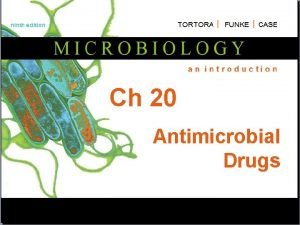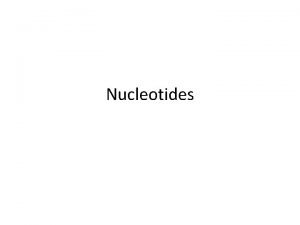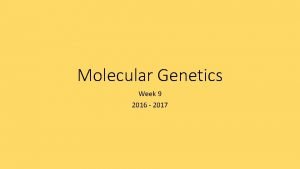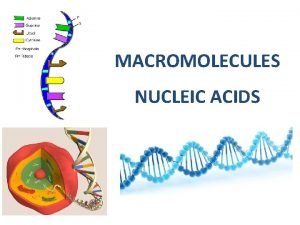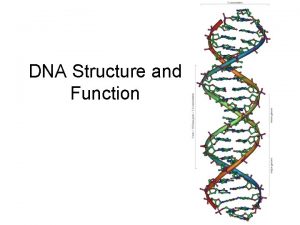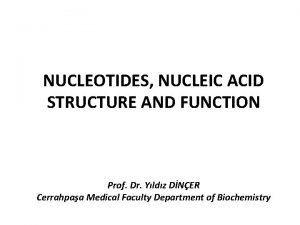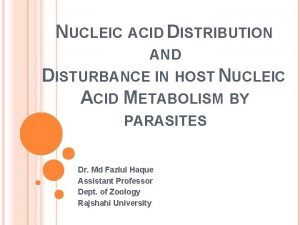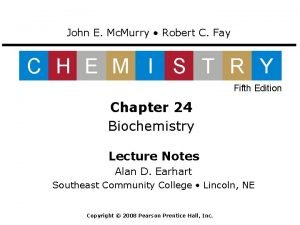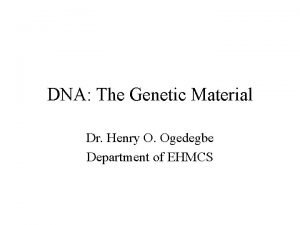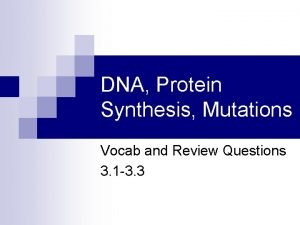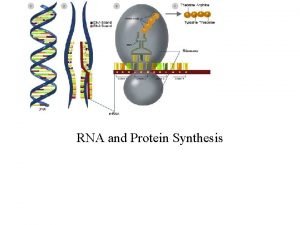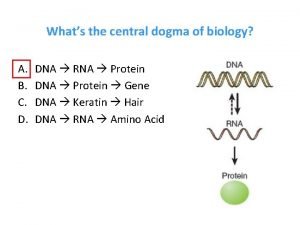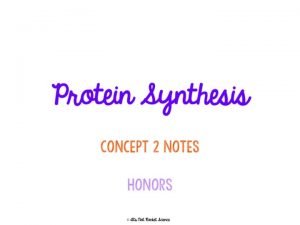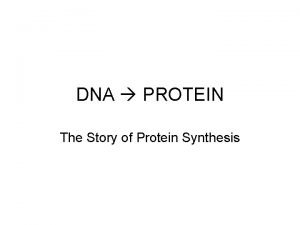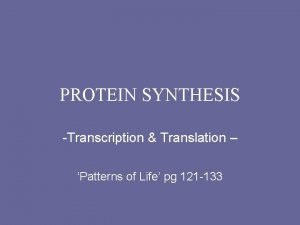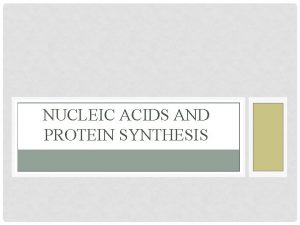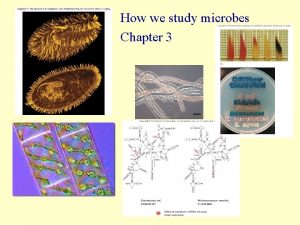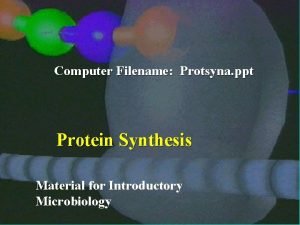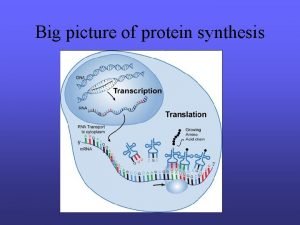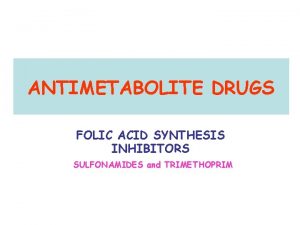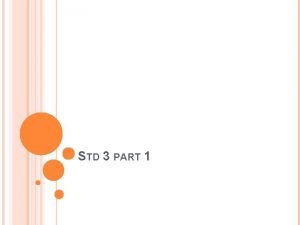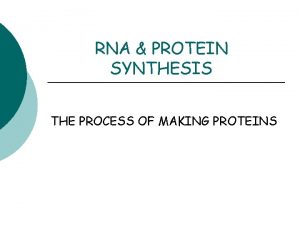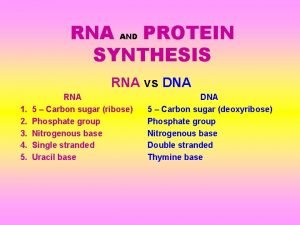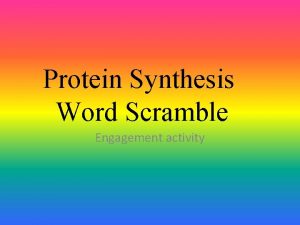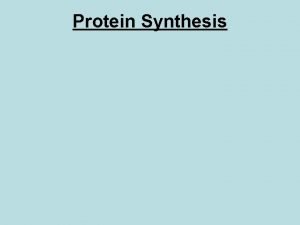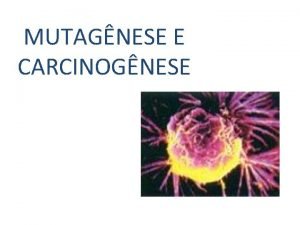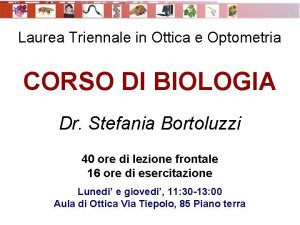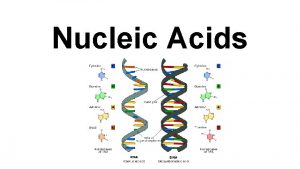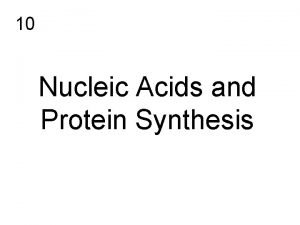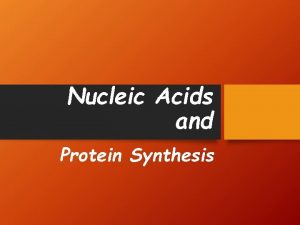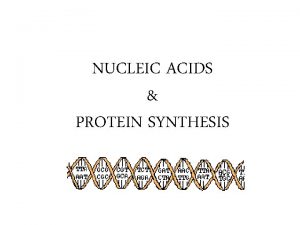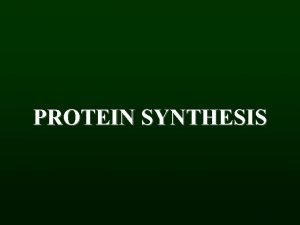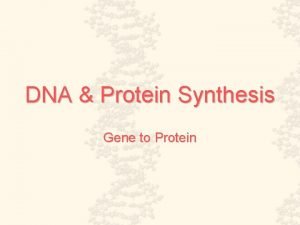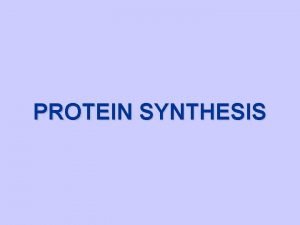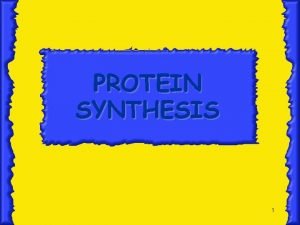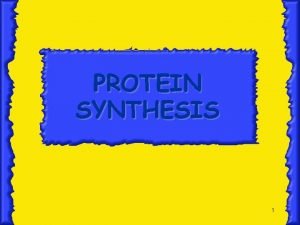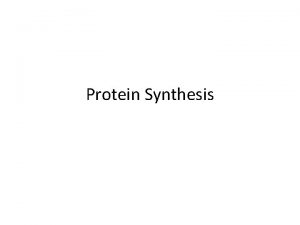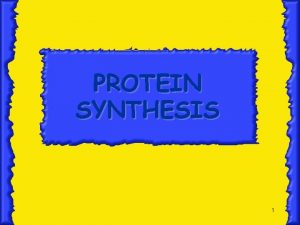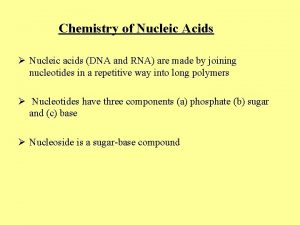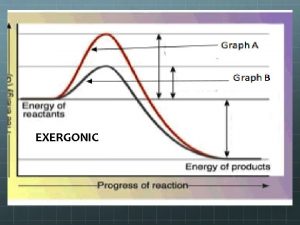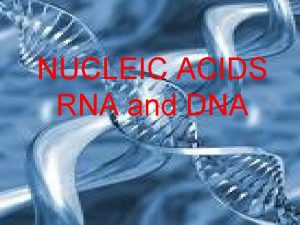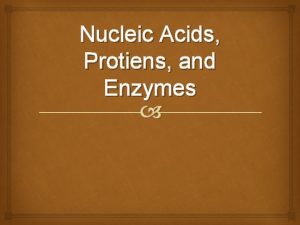Nucleic Acids and Protein Synthesis Nucleic Acids l














































- Slides: 46

Nucleic Acids and Protein Synthesis

Nucleic Acids l DNA l Deoxyribonucleic Acid l RNA l Ribonucleic Acid

DNA l. Double stranded helix l. Never leaves the nucleus l. Watson, Crick, Wilkins won Nobel Prize in 1962 l. Franklin died in 1958 never recognized

DNA

Nucleotide l Building Blocks of nucleic acids are NUCLEOTIDES! l Phospate group l Sugar molecule (deoxyribose) l Nitrogenous bases

Nitrogenous Bases of DNA

How do the N-Bases pair up? A-T (2 bonds) l G-C (3 bonds) l

How Does DNA Replicate? l l l 1. double helix unwinds 2. Each chain serves as a template for new nucleoide chain 3. point at which 2 chains separate is called the REPLICATION FORK. 4. HELICASE = the enzyme that separates the chains (breaks H bonds) 5. DNA POLYMERASE moves along the chains and helps assemble new nucleotides forming new chains (3’ to 5’ ONLY) DNA LIGASE – ligates 5’ to 3’ (DNA polymerase brings the nucleotides)

DNA replication continue… The 3’ sugar has an –OH GROUP l The 5’ sugar has a PHOSPHATE GROUP l LEADING STRAND – formed from 3’-5’ l LAGGING STRAND – formed from 5’- 3’ with the help of DNA LIGASE! l OKAZAKI FRAGMENTS – fragments that will be ligated together l

Can you see how DNA is making an exact copy of itself! l *

This a little more difficult l Can you figure out the diagram?


Simplest Illustration of DNA replication…

What is a l mutation? ? A CHANGE in the nucleotide sequence at even ONE location!!

Protection l About 1 in a billion nucleotides in DNA is INCORRECTLY paired. l DNA polymerase proofreads and removes nucleotides that base pair incorrectly. l DNA polymerase & DNA ligase also repair damage caused by ultraviolet light, xrays, and toxic chemicals

Archibald Garrod 1909 English Physician Suggested that genes dictate phenotypes through enzymes, the proteins that catalyze chemical processes in the cell l GENOTYPE genetic make up l PHENOTYPE physical appearance l DNA –(transcription) RNA – (translation) protein synthesis l Genotype ------ phenotype l

Garrod 1900’s Children -> defect in 2 a. a. due to defect in the enz. That helps make the a. a l Phenylalanine->PKU l Tyrosine ->albinism l Gene enzyme amino acid (can’t be made) l Couldn’t prove it due to lack of technology l

George Beadle & Edward Tatum 1940’s American Geneticists ONE GENE ONE ENZYME (polypeptide) HYPOTHESIS: the function of a gene is to dictate the production of a specific enzyme. l Experimented with bread mold lacked an enzyme in a metabolic pathway that produced some molecules that mold needed to produce an amino acid called arginine. l

Tatum & Beadle 1958 Nobel Prize Proved Garrod correct l Bread mold -> can make all of it’s own a. a. that it needs l Gene -> enzyme -> amino acid l One gene = enzyme l One gene = one protein!! l

RNA RIBONUCLEIC ACID l SINGLE STRANDED l RESPONSIBLE FOR BRINGING THE GENETIC INFO. FROM THE NUCLEUS TO THE CYTOSOL!

RNA Nucleotide l Phosphate l Sugar group molecule (ribose) l Nitrogenous bases l Adenine – URACIL l Cytosine - guanine

3 Kinds of RNA m. RNA – (messenger) brings info from DNA in nucleus to cytosol in eukaryotic cells (uncoiled) l t. RNA –(transfer) brings amino acids to m. RNA for translation (hairpin shape) l r. RNA –(ribosomal) most abundant, r. RNA makes up the ribosomes where proteins are made (globular) l

TRANSCRIPTION!! DNA RNA l 1. RNA polymerase-initiates transcription by binding to region on DNA called PROMOTER (causes DNA to separate)-INITIATION PHASE l 2. only ONE of the DNA chains will be used for transcription it’s called the TEMPLATE (promoter dictates which of the two strands will be used) l 3. RNA POLYMERASE – attached to first DNA nucleotide of template chain – then begins adding complementary RNA nucleotides. ELONGATION PHASE

Cont. Transcription l 4. transcription continues until RNA polymerase reaches a TERMINATION SIGNAL on the DNA-TERMINATION PHASE l 5. RNA polymerase releases both the DNA mol. And newly formed RNA mol. Are transcribed in this way (all three!!!)

RNA l *

RNA replications

PROKARYOTES l. Transcription and translation occur in the SAME place! l. NO NUCLEUS!

Eukaryotes 1. Before RNA leaves the nucleus: l G (guanine) cap is attached l A (adenine) tail is attached “many” l l 2. These protect the RNA from attack by cellular enzymes and help ribosomes to recognize the m. RNA (cap & tail are NOT translated)

Cont. Eukaryotes l 3. INTRONS (non coding sequence) are removed l 4. EXONS (part of gene that are expressed) are joined to produce a m. RNA molecule with a continuous coding sequence. l NOW RNA CAN LEAVE THE NUCLEUS!


Protein Synthesis l. PROTEINS CARRY OUT THE GENETIC INSTRUCTIONS ENCODED IN AN ORGANISM’S DNA!!!!

TRANSLATION The process of assembling from info. Encoded in a m. RNA! 1. m. RNA leaves nucleus l 2. m. RNA migrates to ribosome in cytosol for protein synthesis l 3. amino acids floating in cytosol are transported to ribosomes by t. RNA molecule l 4. peptide bonds join the amino acids to make polypeptide chain l

Vocabulary! l l l 1. GENETIC CODE: correlation between a nucleotide sequence and an amino acid sequence 2. CODON 3 m. RNA nucleotides, codes for a specific amino acid (64) 3. START CODON (AUG) & a. a. methionine 4. STOP CODON (UAA, UAG, UGA) 5. ANTICODON – 3 t. RNA nucleotides carrying a specific amino acid!

Protein Synthesis l *

Protein Synthesis l *

Protein Synthesis l !

THE SUMMARY!

Ribosome factory for polypeptides l Two subunits: l Large subunit (top) l Small subunit (bottom)

P site – holds t. RNA carrying growing polypeptide A Site – holds t. RNA carrying the next amino acid to be added

Initiation Codon Marks the Start of an m. RNA message l 3 PHASES: l 1. INITIATION l 2. ELONGATION l 3. TERMINATION

INITIATION ( 2 steps) A) An m. RNA mol. Binds to a small ribosomal subunit. A special initiator t. RNA binds to the specific codon called the START CODON (UAC binds to start codon AUG methionine) l B) A large ribosomal subunit binds to the small one creating a functional ribosome. The initiator t. RNA fits into the P site of the ribosome. l

Elongation and Termination l Elongation adds amino acids to the polypeptide chain until a stop codon terminates translation.

3 Steps of Elongation 1. Codon recognition anticodon of incoming t. RNA carrying amino acid pairs with m. RNA codon in A site. l 2. Peptide bond formation polypeptide separates from t. RNA (fr. P site). Peptide bond forms between amino acid in P & A site ribosome catalyzes formation of bond. l l CONTINUE…. .

CONTINUE… l 3. Translation P site t. RNA now leaves ribosome, the ribosome translocates (moves) the t. RNA in the A site, with its attached polypeptide to the P site. The codon and anticodon remain bonded and the m. RNA and t. RNA move as a unit. This movement brings into the A site the next m. RNA codon to be translated and process can start again! ELONGATION CONTINUES UNTIL A STOP CODON REACHES A SITE.


 Clindamycin metabolism
Clindamycin metabolism Building blocks for nucleic acids
Building blocks for nucleic acids Nucleic acids composition
Nucleic acids composition What is an anticodon
What is an anticodon Nucleic acids monomers building blocks
Nucleic acids monomers building blocks Polymer structure of nucleic acids
Polymer structure of nucleic acids Function of nucleic acids
Function of nucleic acids Ribonucleotide vs deoxyribonucleotide
Ribonucleotide vs deoxyribonucleotide Nucleoside and nucleotide
Nucleoside and nucleotide Nucleoide funcion
Nucleoide funcion Store and transmit genetic information
Store and transmit genetic information Nucleic acid
Nucleic acid Food that rich in nucleic acid
Food that rich in nucleic acid Nucleic acids
Nucleic acids Function of nucleic acids
Function of nucleic acids Section 12 3 rna and protein synthesis
Section 12 3 rna and protein synthesis Missense mutation in sickle cell anemia
Missense mutation in sickle cell anemia Protein synthesis and mutations
Protein synthesis and mutations Protein synthesis and mutations
Protein synthesis and mutations Dna protein synthesis study guide answers
Dna protein synthesis study guide answers Rna transfer
Rna transfer Rna protein synthesis
Rna protein synthesis Messenger rna codons
Messenger rna codons Protein synthesis restaurant analogy
Protein synthesis restaurant analogy Transcription and translation
Transcription and translation Bbc bitesize protein synthesis
Bbc bitesize protein synthesis Cookie monster analogy
Cookie monster analogy Elongation
Elongation Transfer rna
Transfer rna Protein synthesis
Protein synthesis Protein synthesis
Protein synthesis Synthesis
Synthesis Protein synthesis animation mcgraw hill
Protein synthesis animation mcgraw hill Molecular genetics
Molecular genetics Translate
Translate Protein synthesis
Protein synthesis Protein synthesis
Protein synthesis Protein synthesis ppt
Protein synthesis ppt Picture of protein synthesis
Picture of protein synthesis Methoteraxate
Methoteraxate Which best summarizes the process of protein synthesis?
Which best summarizes the process of protein synthesis? Concept map of protein synthesis
Concept map of protein synthesis Protein synthesis
Protein synthesis Protein synthesis scramble
Protein synthesis scramble Process of protein synthesis
Process of protein synthesis Protein synthesis
Protein synthesis Protein synthesis
Protein synthesis
